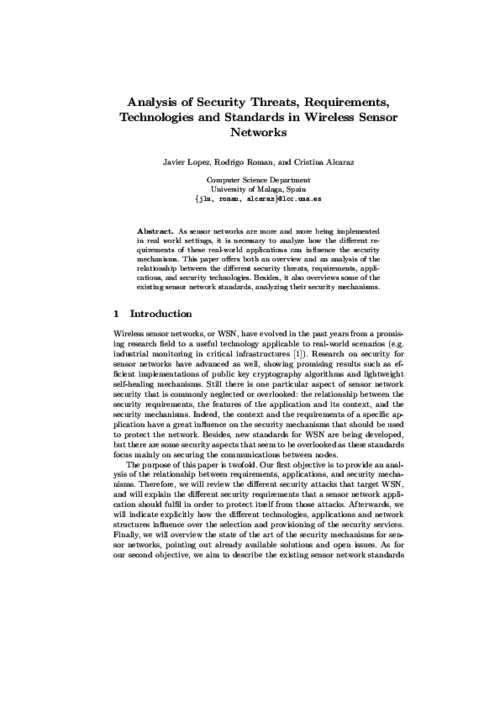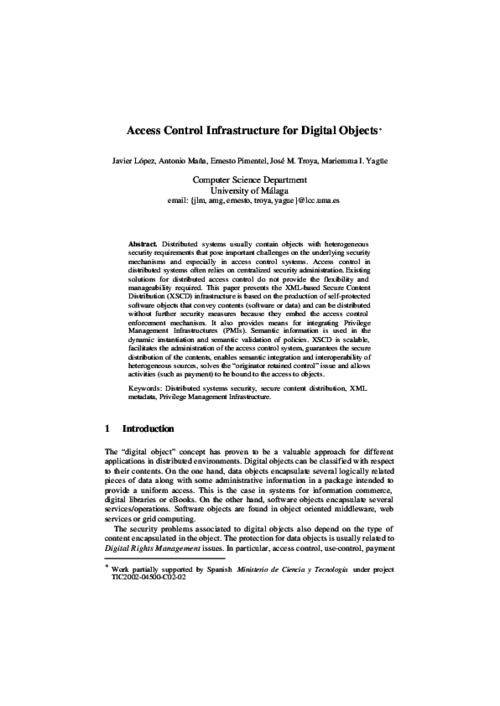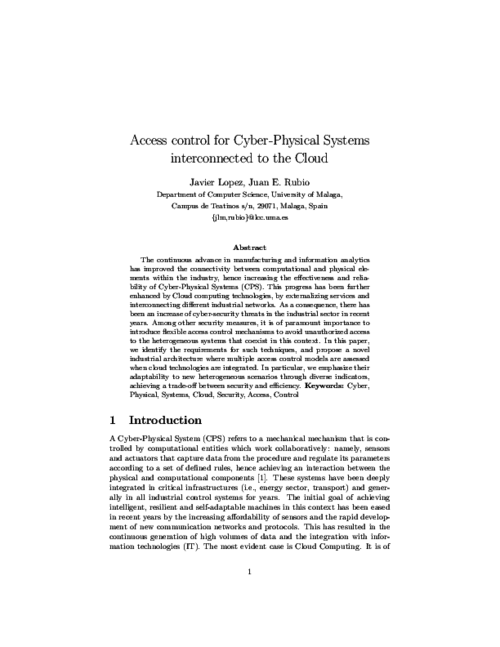 ] Title Type Year
] Title Type Year |
"Advances in Critical Infrastructure Protection: Information Infrastructure Models, Analysis, and Defense", LNCS, vol. 6715, Springer, 2012.  |  |
IEEE International Workshop on Web Semantics (WebS’03), IEEE Press, pp. 622-626, 2003.

Computer Networks, vol. 134, Elsevier, pp. 46 - 54, 2018. DOI
11th International SDL Forum (SDL’03), LNCS 2708, Springer-Verlag, pp. 300-317, July, 2003.
Abstract
Nowadays, it is widely accepted that critical systems have to be formally analysed in order to achieve well-known formal method benefits. In order to study the security of communication systems, we have developed a methodology for the application of the formal analysis techniques commonly used in communication protocols to the analysis of cryptographic ones. In particular, we have extended the design and analysis phases with security properties. Our proposal uses a specification notation based on MSC, which can be automatically translated into a generic SDL specification. This SDL system can then be used for the analysis of the desired security properties, by using an observer process schema. Apart from our main goal of providing a notation for describing the formal specification of security systems, our proposal also brings additional benefits, such as the study of the possible attacks to the system, and the possibility of re-using the specifications produced to describe and analyse more complex systems.

International Conference on Imaging Science, Systems, and Technology (CISST’98), July, 1998.
Computers & Security, vol. 23, no. 7, Elsevier, pp. 578-590, 2004.
Abstract
In this article, we argue that traditional approaches for authorization and access control in computer systems (i.e., discretionary, mandatory, and role-based access controls) are not appropriate to address the requirements of networked or distributed systems, and that proper authorization and access control requires infrastructural support in one way or another. This support can be provided, for example, by an authentication and authorization infrastructure (AAI). Against this background, we overview, analyze, discuss, and put into perspective some technologies that can be used to build and operate AAIs. More specifically, we address Microsoft .NET Passport and some related activities (e.g. the Liberty Alliance Project), Kerberos-based solutions, and AAIs that are based on digital certificates and public key infrastructures (PKIs). We conclude with the observation that there is no single best approach for providing an AAI, that every approach has specific advantages and disadvantages, and that a comprehensive AAI must combine various technologies and approaches.

Simposio Español de Informática Distribuida (SEID’00), pp. 313-320, Septiembre, 2000.
Abstract
La seguridad es uno de los aspectos más conflictivos del uso de Internet. La falta de una política de seguridad global está frenando el desarrollo de Internet en áreas tan interesantes y prometedoras como el comercio electrónico o la interacción con las administraciones públicas. Las técnicas criptográficas actuales proporcionan un alto grado de confidencialidad; no obstante, es difícil garantizar la identificación segura de los usuarios y, además, la gestión de las claves de los mismos es poco eficiente y presenta graves problemas de escalabilidad. Este trabajo describe las características de implementación de una solución a ambos problemas basada en una Infraestructura de Clave Pública (PKI) que proporciona una administración simple y eficiente de las claves de los usuarios y posibilita la autenticación segura de los mismos.

Foundations of Security Analysis and Design 2009, LNCS 5705, Springer Berlin/Heidelberg, pp. 289-338, August, 2009. DOI
Abstract
As sensor networks are more and more being implemented in real world settings, it is necessary to analyze how the different requirements of these real-world applications can influence the security mechanisms. This paper offers both an overview and an analysis of the relationship between the different security threats, requirements, applications, and security technologies. Besides, it also overviews some of the existing sensor network standards, analyzing their security mechanisms.

International Conference on Information and Communications Security (ICICS’02), LNCS 2513, Springer-Verlag, pp. 399-410, December, 2002.
Abstract
Distributed systems usually contain objects with heterogeneous security requirements that pose important challenges on the underlying security mechanisms and especially in access control systems. Access control in distributed systems often relies on centralized security administration. Existing solutions for distributed access control do not provide the flexibility and manageability required. This paper presents the XML-based Secure Content Distribution (XSCD) infrastructure is based on the production of self-protected software objects that convey contents (software or data) and can be distributed without further security measures because they embed the access control enforcement mechanism. It also provides means for integrating Privilege Management Infrastructures (PMIs). Semantic information is used in the dynamic instantiation and semantic validation of policies. XSCD is scalable, facilitates the administration of the access control system, guarantees the secure distribution of the contents, enables semantic integration and interoperability of heterogeneous sources, solves the “originator retained control” issue and allows activities (such as payment) to be bound to the access to objects.

